Author: Ricardo S. Morse
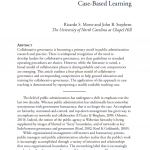
Teaching Collaborative Governance: Phases, Competencies, and Case-Based Learning
Collaborative governance is becoming a primary motif in public administration research and practice. There is widespread recognition of the need to develop leaders for collaborative governance, yet clear guidelines or standard operating procedures are elusive. However, while the literature is varied, a broad model of collaboration phases is distinguishable and core competencies are emerging. This article outlines a four-phase model of collaborative governance and corresponding competencies to help ground education and training for collaborative governance. The application of this approach to case teaching is demonstrated by repurposing a readily available teaching case.
Cite as:
…
Continued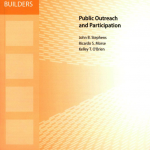
Public Outreach and Participation
Although city and county elected officials frequently hear from their constituents, officials and citizens often do not fully understand how public participation occurs and how it informs decision making by municipal and county boards.
This book, part of the Local Government Board Builders series, offers ideas for engaging the public, assesses the strengths and weaknesses of a variety of participation mechanisms, and provides guidance for better public outreach. It also discusses ways of developing long-term community participation.
See the Local Government Board Builders Series webpage for other books in the series and related School of Government publications.
Cite as:
Stephens, J., Morse, R. and O’Brien, K. (2011). Public Outreach and Participation. [Chapel Hill, N.C.]: UNC School of Government.
…
Continued
From Local Managers to Community Change Agents: Lessons From an Executive Leadership Program Experience
Since fall 2003, the Public Leadership faculty of the University of North Carolina at Chapel Hill (UNC) School of Government (SOG) has worked on the design and delivery of the Public Executive Leadership Academy (PELA), an advanced leadership program for local managers. PELA serves a diverse audience of twenty-five municipal and county managers, assistant managers, and department heads who aspire to leadership careers in local government and need to hone or develop their communication and collaboration skills. The program’s curriculum is unique in its focus on the manager’s role as community leader and change agent, and its emphasis on leading and managing in an intergovernmental and intersector context. Participants apply information and insights from class sessions to their “real world” change opportunity back home. To our knowledge, no other university-based public executive leadership program in the United States has this emphasis. As we reflect on the past two years of experience, we have learned a great deal. The purpose of this chapter is to share these lessons with those interested in developing similar leadership programs. Our focus is on: (1) partnership management, (2) collaboration, (3) curriculum design, (4) team-building techniques, and (5) program evaluation.
Cite as:
Morse, Ricardo S., and Terry F. Buss. Innovations in Public Leadership Development, Routledge, 2008. ProQuest Ebook Central, http://ebookcentral.proquest.com/lib/unc/detail.action?docID=1900028.
Created from unc on 2019-04-05 11:47:52.
…
Continued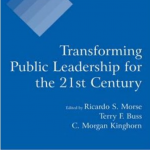
Transforming Public Leadership for the 21st Century
This book explores what this shift looks like and offers guidance on what it should look like. Specifically, the book focuses on the role of career leaders: those in public service who are change agents not only in their organizations but also in their communities and policy domains. These leaders work in network settings, making connections and collaborating to create public value and advance the common good.
Cite as:
Morse, Ricardo S., Terry F. Buss, and C. Morgan Kinghorn, eds. 2007. Transforming Public Leadership for the 21st Century. New York: Routledge.
…
Continued
Focusing the Public Leadership Lens: Research Propositions and Questions in the Minnowbrook Tradition
Although there is no shortage of general studies and theories of leadership, the same cannot be said for public leadership. This concern surfaced as a critical issue among scholars at the 2008 Minnowbrook III conference. Drawing from that discussion, this article calls for invigorating the study of public leadership within public administration (PA). We present the case for public leadership, that is, leadership for the public good, where challenges are complex, stakeholders are many, values are conflicting, and resources are limited. Traditional, generic models of leadership—as in, leading followers toward some specific goal—do not align well with these current challenges. We argue for studying public leadership specifically, rather than trying to retrofit existing concepts of leadership from business management or elective politics. PA should be the leading voice in understanding and promoting public leadership. By examining previous public leadership scholarship through three broad lenses—the character of public leadership, the function of public leadership, and the jurisdiction of public leadership—we develop theoretical propositions designed to drive a revitalized research agenda. We conclude with a set of research questions we see as critical to crystallizing the significance of public leadership.
Cite as:
Heather Getha-Taylor, Maja Husar Holmes, Willow S. Jacobson, Ricardo S. Morse, Jessica E. Sowa, Focusing the Public Leadership Lens: Research Propositions and Questions in the Minnowbrook Tradition, Journal of Public Administration Research and Theory, Volume 21, Issue suppl_1, January 2011, Pages i83–i97, https://doi.org/10.1093/jopart/muq069
…
Continued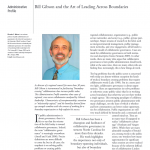
Bill Gibson and the Art of Leading Across Boundaries
As director of a regional council for more than 30 years, Bill Gibson is instrumental in facilitating “boundary-crossing” collaborations that increase public value. This Administrative Profile examines three cases of regional, cross-sector collaboration catalyzed by Gibson’s leadership. Characteristics of entrepreneurship, attention to “relationship capital,” and the humility derived from ego strength combine with the context of working for a boundary organization to help explain his success.
Cite as:
Morse, Ricardo. (2010). Bill Gibson and the Art of Leading Across Boundaries. Public Administration Review. 70. 434 – 442
…
Continued
How Public Service Leadership is Studied: An Examination of a Quarter Century of Scholarship
This exploratory study surveys the public service leadership literature from a selection of leading public administration journals over a 25‐year period (1987–2012). Patterns in methods used to study public leadership are explored, along with how those methods vary across settings within the public service sector and the treatment of leadership in the analysis. While the number of empirical studies of public service leadership has grown, the diversity of theoretical approaches, methods and measures challenges the ability to synthesize findings in order to advance the knowledge base on this topic. This article provides a map of leadership studies within the field of public administration over time and offers prescriptions for future research.
Cite as:
CHAPMAN, C., GETHA-TAYLOR, H., HOLMES, M., JACOBSON, W., MORSE, R. and SOWA, J. (2015). HOW PUBLIC SERVICE LEADERSHIP IS STUDIED: AN EXAMINATION OF A QUARTER CENTURY OF SCHOLARSHIP. Public Administration, 94(1), pp.111-128.
…
Continued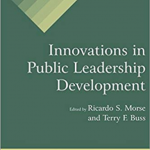
Innovations in Public Leadership Development
This book is grounded in several premises widely shared by our contributors. First, leaders can, and indeed must, be developed if the public sector is to meet its obligations to citizens and its constituents. It is just not the case or our experience that leaders are born and in short supply. Second, although it has some common attributes, public leadership differs from leadership in other contexts, such as military, sports, or business. Military models of leadership, for example, remain focused on hierarchical structures of authority, whereas public leaders now find themselves leading much more in a collaborative environment. Third, the practice of public leadership is in crisis, or at least in turmoil, necessitating new ways of leading and alternative ways of developing leaders. Public confidence in government is low, traditional ways of doing business are becoming obsolete, scandal appears to be permeating government, management and administration are becoming increasingly political, and the quality of public services seems on the decline. New leaders are desperately needed. And fourth, a wide variety of training and development innovations are underway that can, and are producing public leaders who have been or will be effective in today’s environment. These innovations, many presented here, are grounded in practice rather than theory, have been tested and evaluated for effectiveness, and are beginning to attract a large following in the field. The contributors hope that their work conveys the exciting times in which we find ourselves in the field of public management and the unprecedented opportunities for advancing leadership development.
Cite as:
Morse, Ricardo S., and Terry F. Buss. Innovations in Public Leadership Development, Routledge, 2008. ProQuest Ebook Central, http://ebookcentral.proquest.com/lib/unc/detail.action?docID=1900028.
Created from unc on 2019-04-02 09:16:13.
…
Continued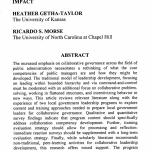
Collaborative Leadership Development for Local Government Officials
The increased emphasis on collaborative governance across the field of public administration necessitates a rethinking of what the core competencies of public managers are and how they might be developed. The traditional model of leadership development, focusing on leading within bounded hierarchy and via command-and-control must be moderated with an additional focus on collaborative problem solving, working in flattened structures, and incentivizing behavior in new ways. This article reviews relevant literature along with the experience of two local government leadership programs to explore content and training approaches needed to prepare local government leaders for collaborative governance. Qualitative and quantitative survey findings indicate that program content should specifically address collaboration competency development. Further, training evaluation strategy should allow for processing and reflection: immediate reaction surveys should be supplemented with a long-term evaluation strategy. Finally, while scholarly literature recommends non-traditional, peer-learning activities for collaborative leadership development, this research offers mixed support. The program examples and associated research findings highlight the importance of a strategic approach to training that reflects emerging leadership needs.
Cite as:
GETHA-TAYLOR, H., & MORSE, R. (2013). COLLABORATIVE LEADERSHIP DEVELOPMENT FOR LOCAL GOVERNMENT OFFICIALS: EXPLORING COMPETENCIES AND PROGRAM IMPACT. Public Administration Quarterly,37(1), 71-102. Retrieved from http://www.jstor.org/stable/24371989
…
Continued
Collaborative Capital Budgeting in U.S. Local Government
This article explores collaborative capital budgeting in U.S. local governments. To date, the capital budgeting literature has focused on practices within individual governments. This leaves a gap in our understanding because a large portion of capital planning, acquisition, and maintenance occurs through collaboration between two or more local governments. Drawing on the capital budgeting and collaborative public management literature, and on illustrative cases of collaborative capital budgeting in the United States, an inductive approach is used to: (1) identify and categorize the different objectives that motivate local officials to pursue collaborative agreements, (2) examine common patterns in the types of assets involved in collaboration, and (3) discover common institutional arrangements in collaboration agreements. The research findings demonstrate significant heterogeneity in the objectives, patterns, and institutions of collaborative capital budgeting.
Cited as:
Hina Khalid, David S.T. Matkin, Ricardo S. Morse, (2017) “Collaborative capital budgeting in U.S. local government”, Journal of Public Budgeting, Accounting & Financial Management, Vol. 29 Issue: 2, pp.230-262, https://doi.org/10.1108/JPBAFM-29-02-2017-B003
…
Continued- 1
- 2

